Film Makers: Dziga Vertov and Charlie Chaplin's Political Impact
VerifiedAdded on 2023/03/17
|9
|2401
|55
Report
AI Summary
This report analyzes the political and societal impact of film makers Dziga Vertov and Charlie Chaplin. It begins by introducing the idea that movies serve as a visual representation of society, often reflecting and influencing societal events. The report focuses on Vertov's contributions, particularly his introduction of the Montage Movement and its aim to depict the raw reality of societal issues, using his film "Man with the Camera" as a prime example. The report then examines Chaplin's work, highlighting his ability to address societal problems through movies like "Modern Times," which reflected the impact of the Great Depression. The report underscores how these film makers aimed to make audiences aware of political and social issues, ultimately encouraging them to take action for societal betterment. The conclusion reiterates the significance of film in shaping public opinion and promoting societal change, emphasizing that films can provide both entertainment and social commentary.
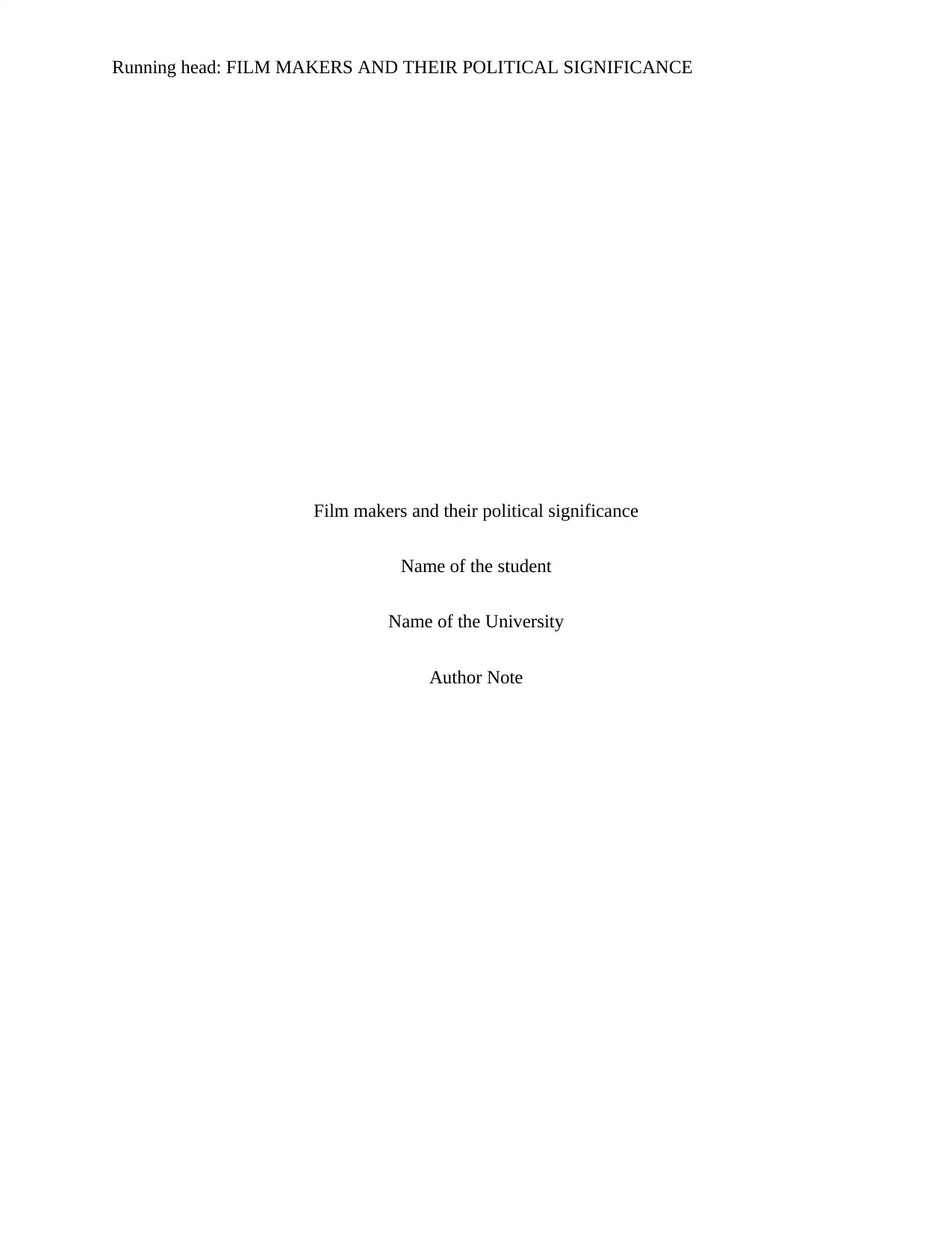
Running head: FILM MAKERS AND THEIR POLITICAL SIGNIFICANCE
Film makers and their political significance
Name of the student
Name of the University
Author Note
Film makers and their political significance
Name of the student
Name of the University
Author Note
Paraphrase This Document
Need a fresh take? Get an instant paraphrase of this document with our AI Paraphraser
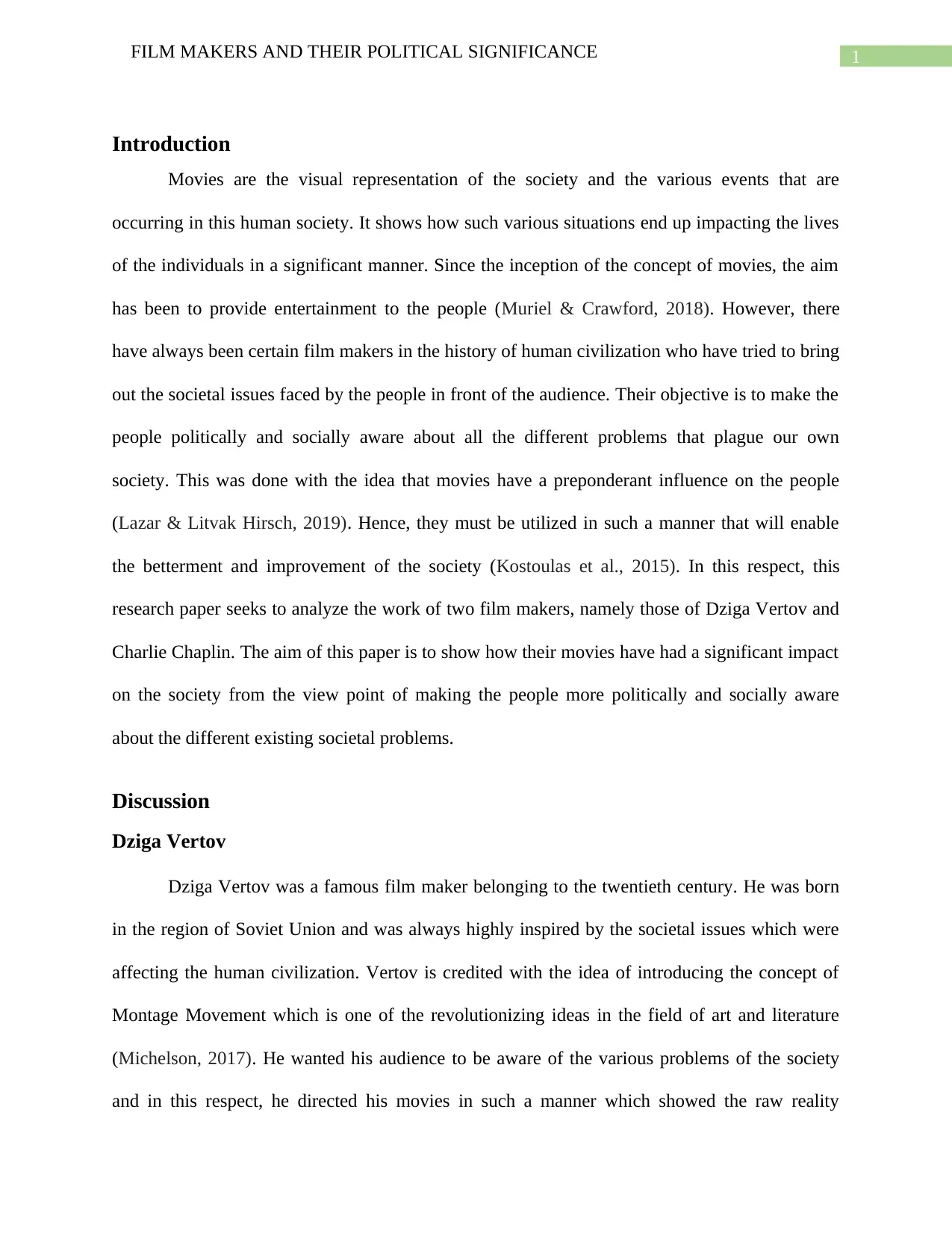
1FILM MAKERS AND THEIR POLITICAL SIGNIFICANCE
Introduction
Movies are the visual representation of the society and the various events that are
occurring in this human society. It shows how such various situations end up impacting the lives
of the individuals in a significant manner. Since the inception of the concept of movies, the aim
has been to provide entertainment to the people (Muriel & Crawford, 2018). However, there
have always been certain film makers in the history of human civilization who have tried to bring
out the societal issues faced by the people in front of the audience. Their objective is to make the
people politically and socially aware about all the different problems that plague our own
society. This was done with the idea that movies have a preponderant influence on the people
(Lazar & Litvak Hirsch, 2019). Hence, they must be utilized in such a manner that will enable
the betterment and improvement of the society (Kostoulas et al., 2015). In this respect, this
research paper seeks to analyze the work of two film makers, namely those of Dziga Vertov and
Charlie Chaplin. The aim of this paper is to show how their movies have had a significant impact
on the society from the view point of making the people more politically and socially aware
about the different existing societal problems.
Discussion
Dziga Vertov
Dziga Vertov was a famous film maker belonging to the twentieth century. He was born
in the region of Soviet Union and was always highly inspired by the societal issues which were
affecting the human civilization. Vertov is credited with the idea of introducing the concept of
Montage Movement which is one of the revolutionizing ideas in the field of art and literature
(Michelson, 2017). He wanted his audience to be aware of the various problems of the society
and in this respect, he directed his movies in such a manner which showed the raw reality
Introduction
Movies are the visual representation of the society and the various events that are
occurring in this human society. It shows how such various situations end up impacting the lives
of the individuals in a significant manner. Since the inception of the concept of movies, the aim
has been to provide entertainment to the people (Muriel & Crawford, 2018). However, there
have always been certain film makers in the history of human civilization who have tried to bring
out the societal issues faced by the people in front of the audience. Their objective is to make the
people politically and socially aware about all the different problems that plague our own
society. This was done with the idea that movies have a preponderant influence on the people
(Lazar & Litvak Hirsch, 2019). Hence, they must be utilized in such a manner that will enable
the betterment and improvement of the society (Kostoulas et al., 2015). In this respect, this
research paper seeks to analyze the work of two film makers, namely those of Dziga Vertov and
Charlie Chaplin. The aim of this paper is to show how their movies have had a significant impact
on the society from the view point of making the people more politically and socially aware
about the different existing societal problems.
Discussion
Dziga Vertov
Dziga Vertov was a famous film maker belonging to the twentieth century. He was born
in the region of Soviet Union and was always highly inspired by the societal issues which were
affecting the human civilization. Vertov is credited with the idea of introducing the concept of
Montage Movement which is one of the revolutionizing ideas in the field of art and literature
(Michelson, 2017). He wanted his audience to be aware of the various problems of the society
and in this respect, he directed his movies in such a manner which showed the raw reality
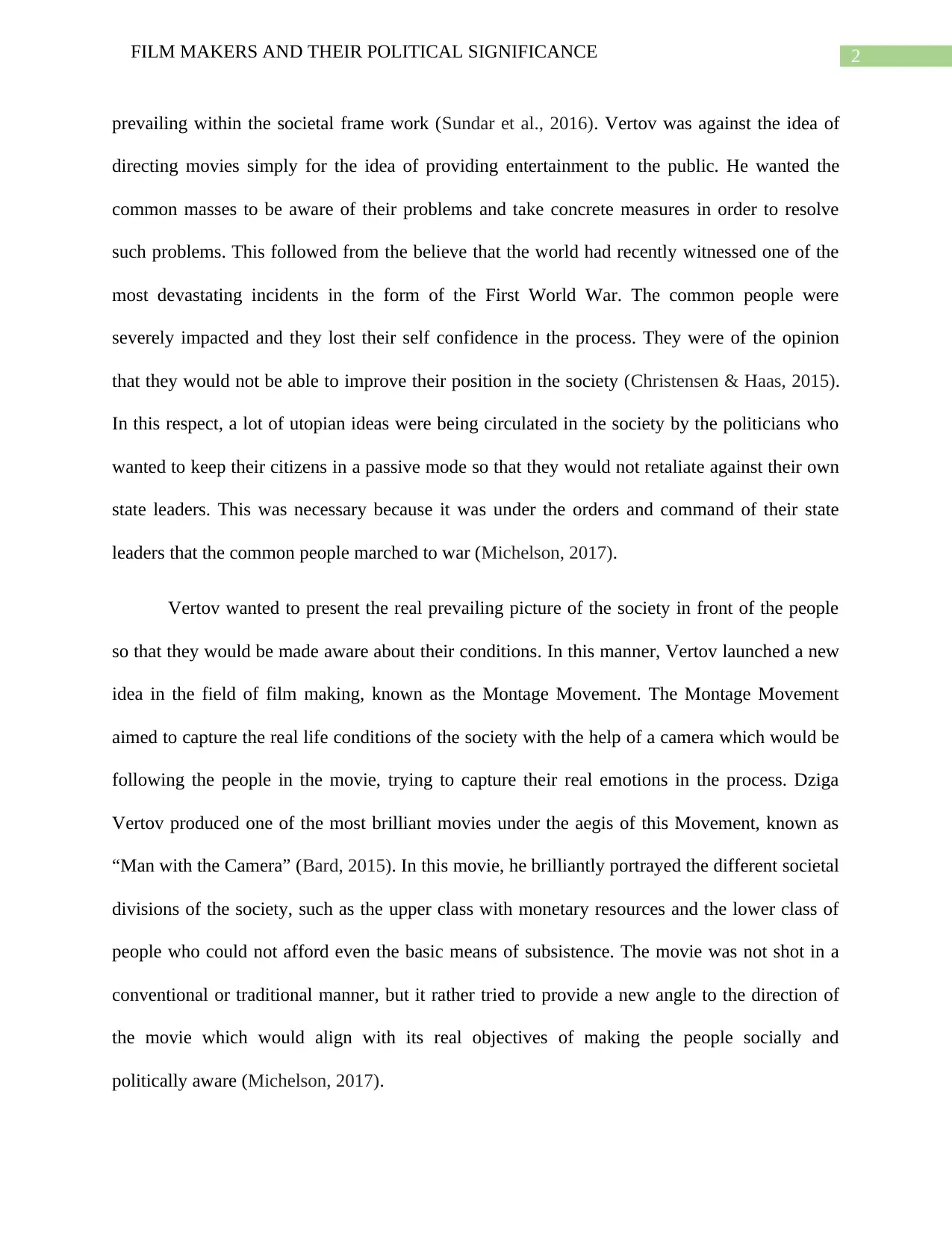
2FILM MAKERS AND THEIR POLITICAL SIGNIFICANCE
prevailing within the societal frame work (Sundar et al., 2016). Vertov was against the idea of
directing movies simply for the idea of providing entertainment to the public. He wanted the
common masses to be aware of their problems and take concrete measures in order to resolve
such problems. This followed from the believe that the world had recently witnessed one of the
most devastating incidents in the form of the First World War. The common people were
severely impacted and they lost their self confidence in the process. They were of the opinion
that they would not be able to improve their position in the society (Christensen & Haas, 2015).
In this respect, a lot of utopian ideas were being circulated in the society by the politicians who
wanted to keep their citizens in a passive mode so that they would not retaliate against their own
state leaders. This was necessary because it was under the orders and command of their state
leaders that the common people marched to war (Michelson, 2017).
Vertov wanted to present the real prevailing picture of the society in front of the people
so that they would be made aware about their conditions. In this manner, Vertov launched a new
idea in the field of film making, known as the Montage Movement. The Montage Movement
aimed to capture the real life conditions of the society with the help of a camera which would be
following the people in the movie, trying to capture their real emotions in the process. Dziga
Vertov produced one of the most brilliant movies under the aegis of this Movement, known as
“Man with the Camera” (Bard, 2015). In this movie, he brilliantly portrayed the different societal
divisions of the society, such as the upper class with monetary resources and the lower class of
people who could not afford even the basic means of subsistence. The movie was not shot in a
conventional or traditional manner, but it rather tried to provide a new angle to the direction of
the movie which would align with its real objectives of making the people socially and
politically aware (Michelson, 2017).
prevailing within the societal frame work (Sundar et al., 2016). Vertov was against the idea of
directing movies simply for the idea of providing entertainment to the public. He wanted the
common masses to be aware of their problems and take concrete measures in order to resolve
such problems. This followed from the believe that the world had recently witnessed one of the
most devastating incidents in the form of the First World War. The common people were
severely impacted and they lost their self confidence in the process. They were of the opinion
that they would not be able to improve their position in the society (Christensen & Haas, 2015).
In this respect, a lot of utopian ideas were being circulated in the society by the politicians who
wanted to keep their citizens in a passive mode so that they would not retaliate against their own
state leaders. This was necessary because it was under the orders and command of their state
leaders that the common people marched to war (Michelson, 2017).
Vertov wanted to present the real prevailing picture of the society in front of the people
so that they would be made aware about their conditions. In this manner, Vertov launched a new
idea in the field of film making, known as the Montage Movement. The Montage Movement
aimed to capture the real life conditions of the society with the help of a camera which would be
following the people in the movie, trying to capture their real emotions in the process. Dziga
Vertov produced one of the most brilliant movies under the aegis of this Movement, known as
“Man with the Camera” (Bard, 2015). In this movie, he brilliantly portrayed the different societal
divisions of the society, such as the upper class with monetary resources and the lower class of
people who could not afford even the basic means of subsistence. The movie was not shot in a
conventional or traditional manner, but it rather tried to provide a new angle to the direction of
the movie which would align with its real objectives of making the people socially and
politically aware (Michelson, 2017).
⊘ This is a preview!⊘
Do you want full access?
Subscribe today to unlock all pages.

Trusted by 1+ million students worldwide
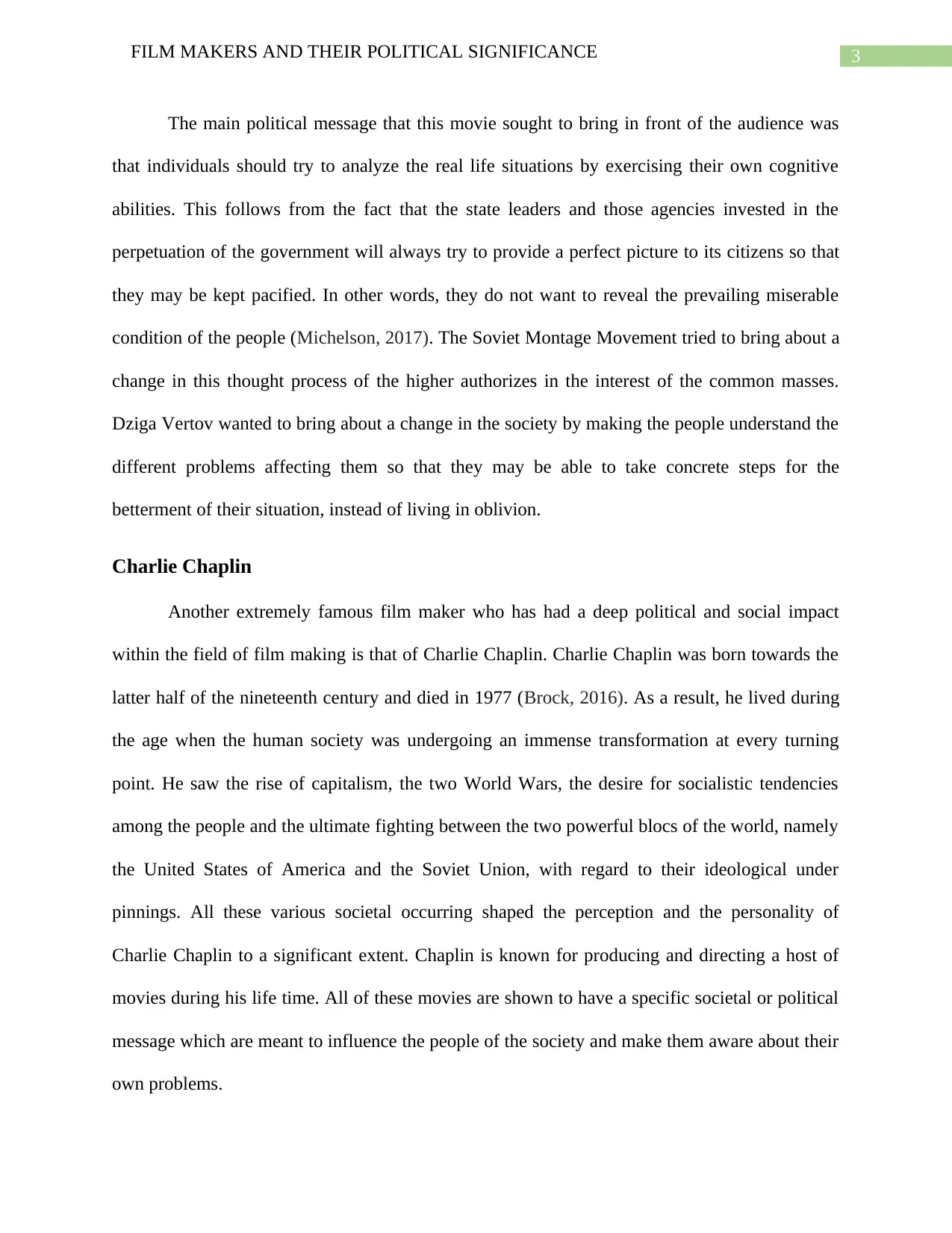
3FILM MAKERS AND THEIR POLITICAL SIGNIFICANCE
The main political message that this movie sought to bring in front of the audience was
that individuals should try to analyze the real life situations by exercising their own cognitive
abilities. This follows from the fact that the state leaders and those agencies invested in the
perpetuation of the government will always try to provide a perfect picture to its citizens so that
they may be kept pacified. In other words, they do not want to reveal the prevailing miserable
condition of the people (Michelson, 2017). The Soviet Montage Movement tried to bring about a
change in this thought process of the higher authorizes in the interest of the common masses.
Dziga Vertov wanted to bring about a change in the society by making the people understand the
different problems affecting them so that they may be able to take concrete steps for the
betterment of their situation, instead of living in oblivion.
Charlie Chaplin
Another extremely famous film maker who has had a deep political and social impact
within the field of film making is that of Charlie Chaplin. Charlie Chaplin was born towards the
latter half of the nineteenth century and died in 1977 (Brock, 2016). As a result, he lived during
the age when the human society was undergoing an immense transformation at every turning
point. He saw the rise of capitalism, the two World Wars, the desire for socialistic tendencies
among the people and the ultimate fighting between the two powerful blocs of the world, namely
the United States of America and the Soviet Union, with regard to their ideological under
pinnings. All these various societal occurring shaped the perception and the personality of
Charlie Chaplin to a significant extent. Chaplin is known for producing and directing a host of
movies during his life time. All of these movies are shown to have a specific societal or political
message which are meant to influence the people of the society and make them aware about their
own problems.
The main political message that this movie sought to bring in front of the audience was
that individuals should try to analyze the real life situations by exercising their own cognitive
abilities. This follows from the fact that the state leaders and those agencies invested in the
perpetuation of the government will always try to provide a perfect picture to its citizens so that
they may be kept pacified. In other words, they do not want to reveal the prevailing miserable
condition of the people (Michelson, 2017). The Soviet Montage Movement tried to bring about a
change in this thought process of the higher authorizes in the interest of the common masses.
Dziga Vertov wanted to bring about a change in the society by making the people understand the
different problems affecting them so that they may be able to take concrete steps for the
betterment of their situation, instead of living in oblivion.
Charlie Chaplin
Another extremely famous film maker who has had a deep political and social impact
within the field of film making is that of Charlie Chaplin. Charlie Chaplin was born towards the
latter half of the nineteenth century and died in 1977 (Brock, 2016). As a result, he lived during
the age when the human society was undergoing an immense transformation at every turning
point. He saw the rise of capitalism, the two World Wars, the desire for socialistic tendencies
among the people and the ultimate fighting between the two powerful blocs of the world, namely
the United States of America and the Soviet Union, with regard to their ideological under
pinnings. All these various societal occurring shaped the perception and the personality of
Charlie Chaplin to a significant extent. Chaplin is known for producing and directing a host of
movies during his life time. All of these movies are shown to have a specific societal or political
message which are meant to influence the people of the society and make them aware about their
own problems.
Paraphrase This Document
Need a fresh take? Get an instant paraphrase of this document with our AI Paraphraser
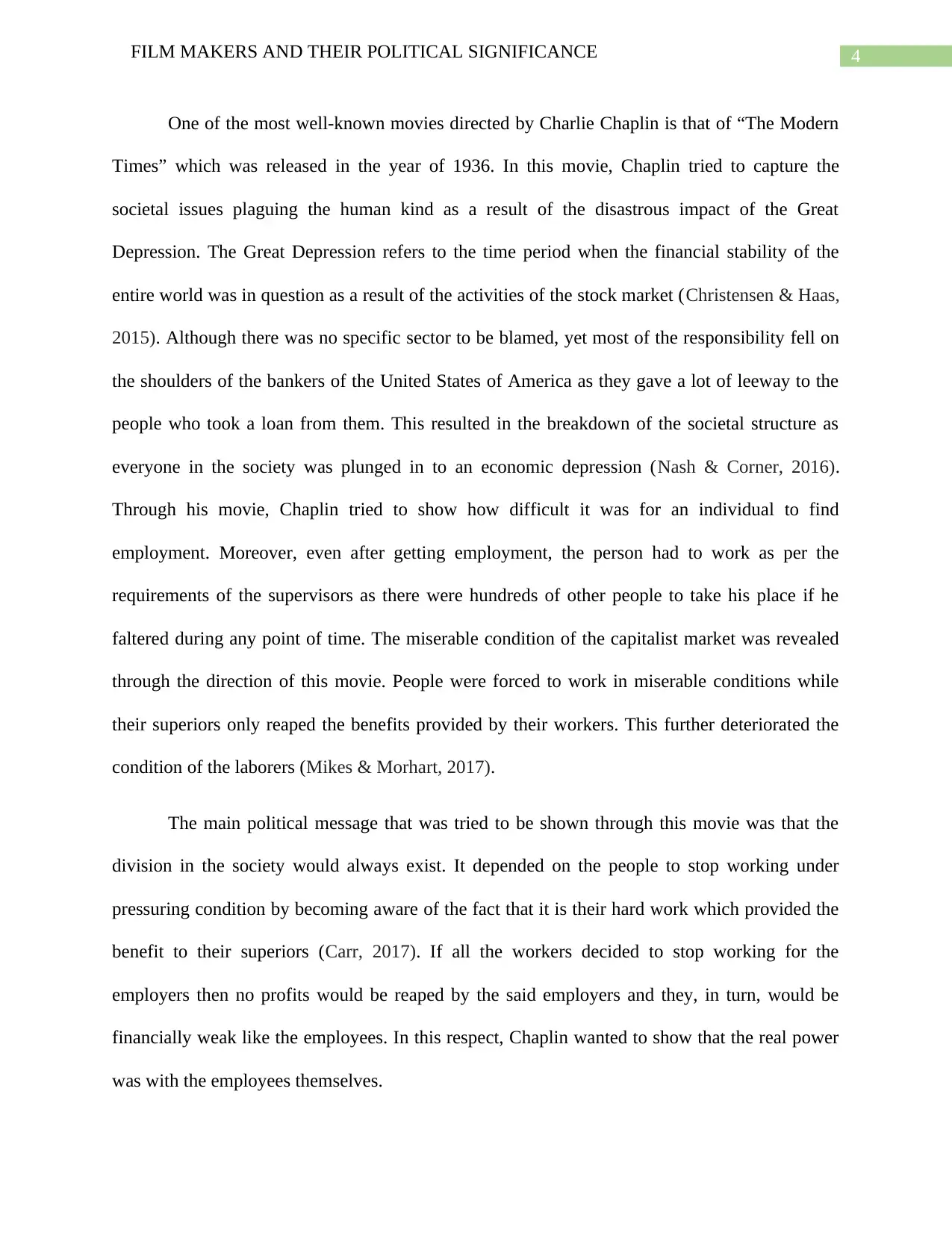
4FILM MAKERS AND THEIR POLITICAL SIGNIFICANCE
One of the most well-known movies directed by Charlie Chaplin is that of “The Modern
Times” which was released in the year of 1936. In this movie, Chaplin tried to capture the
societal issues plaguing the human kind as a result of the disastrous impact of the Great
Depression. The Great Depression refers to the time period when the financial stability of the
entire world was in question as a result of the activities of the stock market (Christensen & Haas,
2015). Although there was no specific sector to be blamed, yet most of the responsibility fell on
the shoulders of the bankers of the United States of America as they gave a lot of leeway to the
people who took a loan from them. This resulted in the breakdown of the societal structure as
everyone in the society was plunged in to an economic depression (Nash & Corner, 2016).
Through his movie, Chaplin tried to show how difficult it was for an individual to find
employment. Moreover, even after getting employment, the person had to work as per the
requirements of the supervisors as there were hundreds of other people to take his place if he
faltered during any point of time. The miserable condition of the capitalist market was revealed
through the direction of this movie. People were forced to work in miserable conditions while
their superiors only reaped the benefits provided by their workers. This further deteriorated the
condition of the laborers (Mikes & Morhart, 2017).
The main political message that was tried to be shown through this movie was that the
division in the society would always exist. It depended on the people to stop working under
pressuring condition by becoming aware of the fact that it is their hard work which provided the
benefit to their superiors (Carr, 2017). If all the workers decided to stop working for the
employers then no profits would be reaped by the said employers and they, in turn, would be
financially weak like the employees. In this respect, Chaplin wanted to show that the real power
was with the employees themselves.
One of the most well-known movies directed by Charlie Chaplin is that of “The Modern
Times” which was released in the year of 1936. In this movie, Chaplin tried to capture the
societal issues plaguing the human kind as a result of the disastrous impact of the Great
Depression. The Great Depression refers to the time period when the financial stability of the
entire world was in question as a result of the activities of the stock market (Christensen & Haas,
2015). Although there was no specific sector to be blamed, yet most of the responsibility fell on
the shoulders of the bankers of the United States of America as they gave a lot of leeway to the
people who took a loan from them. This resulted in the breakdown of the societal structure as
everyone in the society was plunged in to an economic depression (Nash & Corner, 2016).
Through his movie, Chaplin tried to show how difficult it was for an individual to find
employment. Moreover, even after getting employment, the person had to work as per the
requirements of the supervisors as there were hundreds of other people to take his place if he
faltered during any point of time. The miserable condition of the capitalist market was revealed
through the direction of this movie. People were forced to work in miserable conditions while
their superiors only reaped the benefits provided by their workers. This further deteriorated the
condition of the laborers (Mikes & Morhart, 2017).
The main political message that was tried to be shown through this movie was that the
division in the society would always exist. It depended on the people to stop working under
pressuring condition by becoming aware of the fact that it is their hard work which provided the
benefit to their superiors (Carr, 2017). If all the workers decided to stop working for the
employers then no profits would be reaped by the said employers and they, in turn, would be
financially weak like the employees. In this respect, Chaplin wanted to show that the real power
was with the employees themselves.
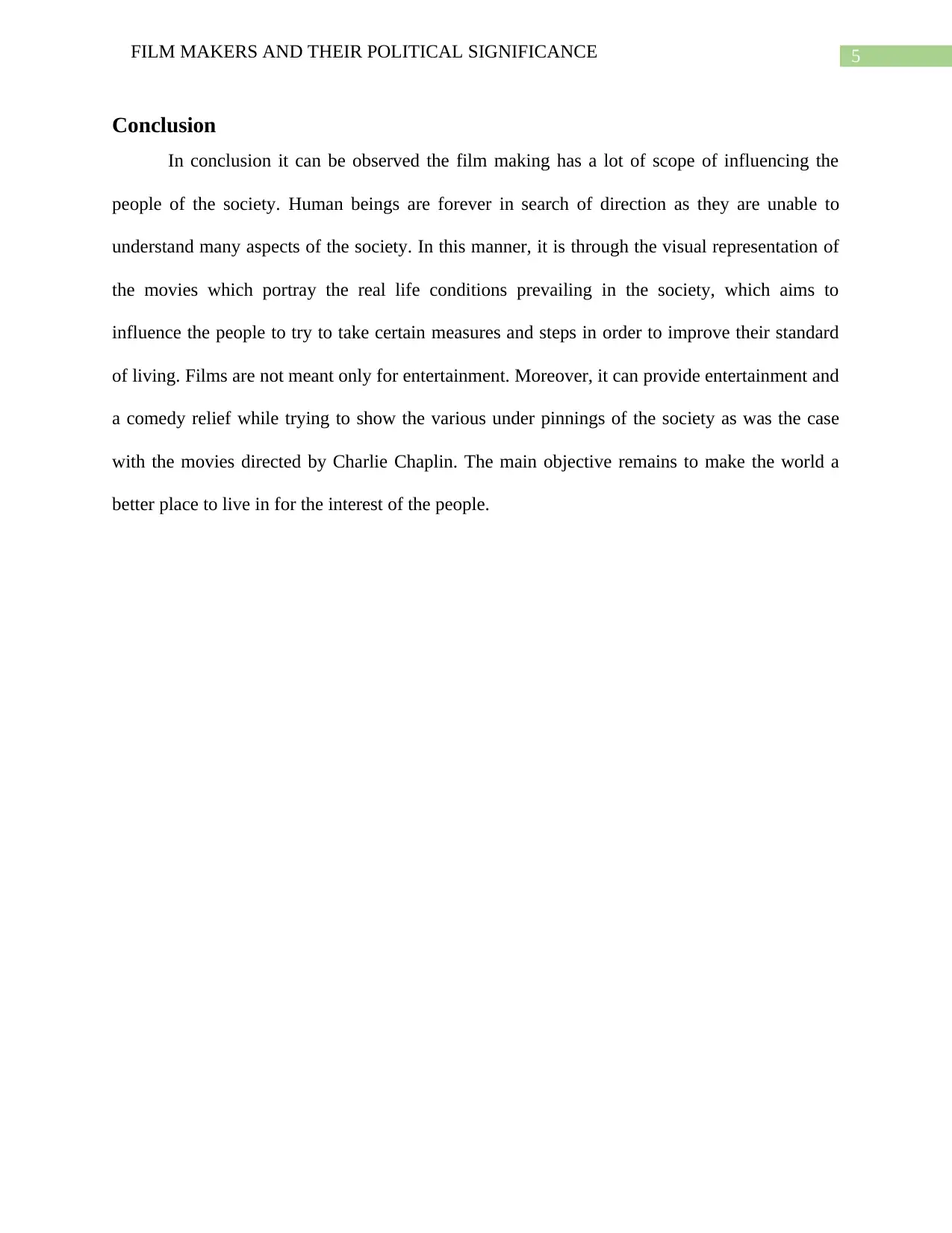
5FILM MAKERS AND THEIR POLITICAL SIGNIFICANCE
Conclusion
In conclusion it can be observed the film making has a lot of scope of influencing the
people of the society. Human beings are forever in search of direction as they are unable to
understand many aspects of the society. In this manner, it is through the visual representation of
the movies which portray the real life conditions prevailing in the society, which aims to
influence the people to try to take certain measures and steps in order to improve their standard
of living. Films are not meant only for entertainment. Moreover, it can provide entertainment and
a comedy relief while trying to show the various under pinnings of the society as was the case
with the movies directed by Charlie Chaplin. The main objective remains to make the world a
better place to live in for the interest of the people.
Conclusion
In conclusion it can be observed the film making has a lot of scope of influencing the
people of the society. Human beings are forever in search of direction as they are unable to
understand many aspects of the society. In this manner, it is through the visual representation of
the movies which portray the real life conditions prevailing in the society, which aims to
influence the people to try to take certain measures and steps in order to improve their standard
of living. Films are not meant only for entertainment. Moreover, it can provide entertainment and
a comedy relief while trying to show the various under pinnings of the society as was the case
with the movies directed by Charlie Chaplin. The main objective remains to make the world a
better place to live in for the interest of the people.
⊘ This is a preview!⊘
Do you want full access?
Subscribe today to unlock all pages.

Trusted by 1+ million students worldwide
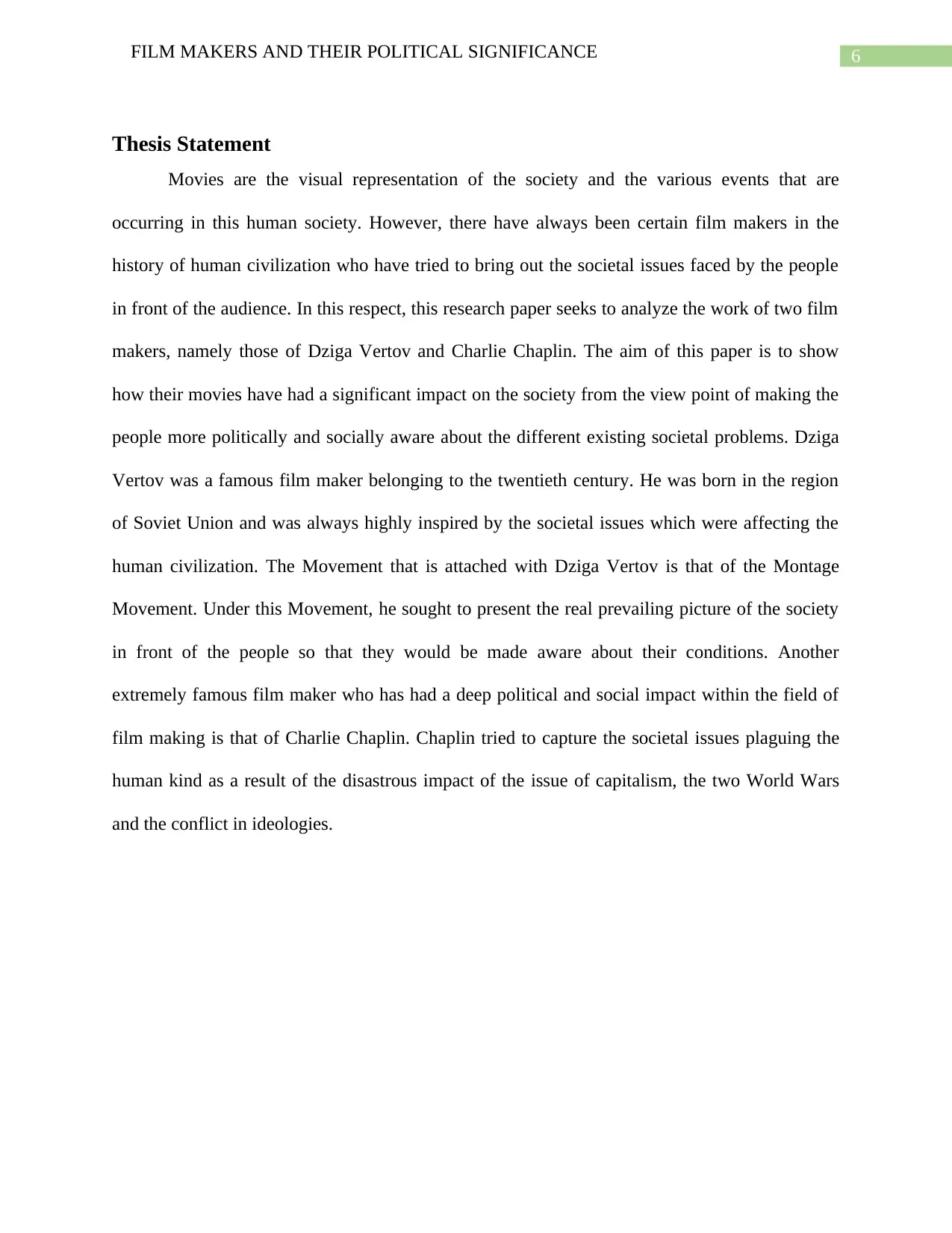
6FILM MAKERS AND THEIR POLITICAL SIGNIFICANCE
Thesis Statement
Movies are the visual representation of the society and the various events that are
occurring in this human society. However, there have always been certain film makers in the
history of human civilization who have tried to bring out the societal issues faced by the people
in front of the audience. In this respect, this research paper seeks to analyze the work of two film
makers, namely those of Dziga Vertov and Charlie Chaplin. The aim of this paper is to show
how their movies have had a significant impact on the society from the view point of making the
people more politically and socially aware about the different existing societal problems. Dziga
Vertov was a famous film maker belonging to the twentieth century. He was born in the region
of Soviet Union and was always highly inspired by the societal issues which were affecting the
human civilization. The Movement that is attached with Dziga Vertov is that of the Montage
Movement. Under this Movement, he sought to present the real prevailing picture of the society
in front of the people so that they would be made aware about their conditions. Another
extremely famous film maker who has had a deep political and social impact within the field of
film making is that of Charlie Chaplin. Chaplin tried to capture the societal issues plaguing the
human kind as a result of the disastrous impact of the issue of capitalism, the two World Wars
and the conflict in ideologies.
Thesis Statement
Movies are the visual representation of the society and the various events that are
occurring in this human society. However, there have always been certain film makers in the
history of human civilization who have tried to bring out the societal issues faced by the people
in front of the audience. In this respect, this research paper seeks to analyze the work of two film
makers, namely those of Dziga Vertov and Charlie Chaplin. The aim of this paper is to show
how their movies have had a significant impact on the society from the view point of making the
people more politically and socially aware about the different existing societal problems. Dziga
Vertov was a famous film maker belonging to the twentieth century. He was born in the region
of Soviet Union and was always highly inspired by the societal issues which were affecting the
human civilization. The Movement that is attached with Dziga Vertov is that of the Montage
Movement. Under this Movement, he sought to present the real prevailing picture of the society
in front of the people so that they would be made aware about their conditions. Another
extremely famous film maker who has had a deep political and social impact within the field of
film making is that of Charlie Chaplin. Chaplin tried to capture the societal issues plaguing the
human kind as a result of the disastrous impact of the issue of capitalism, the two World Wars
and the conflict in ideologies.
Paraphrase This Document
Need a fresh take? Get an instant paraphrase of this document with our AI Paraphraser
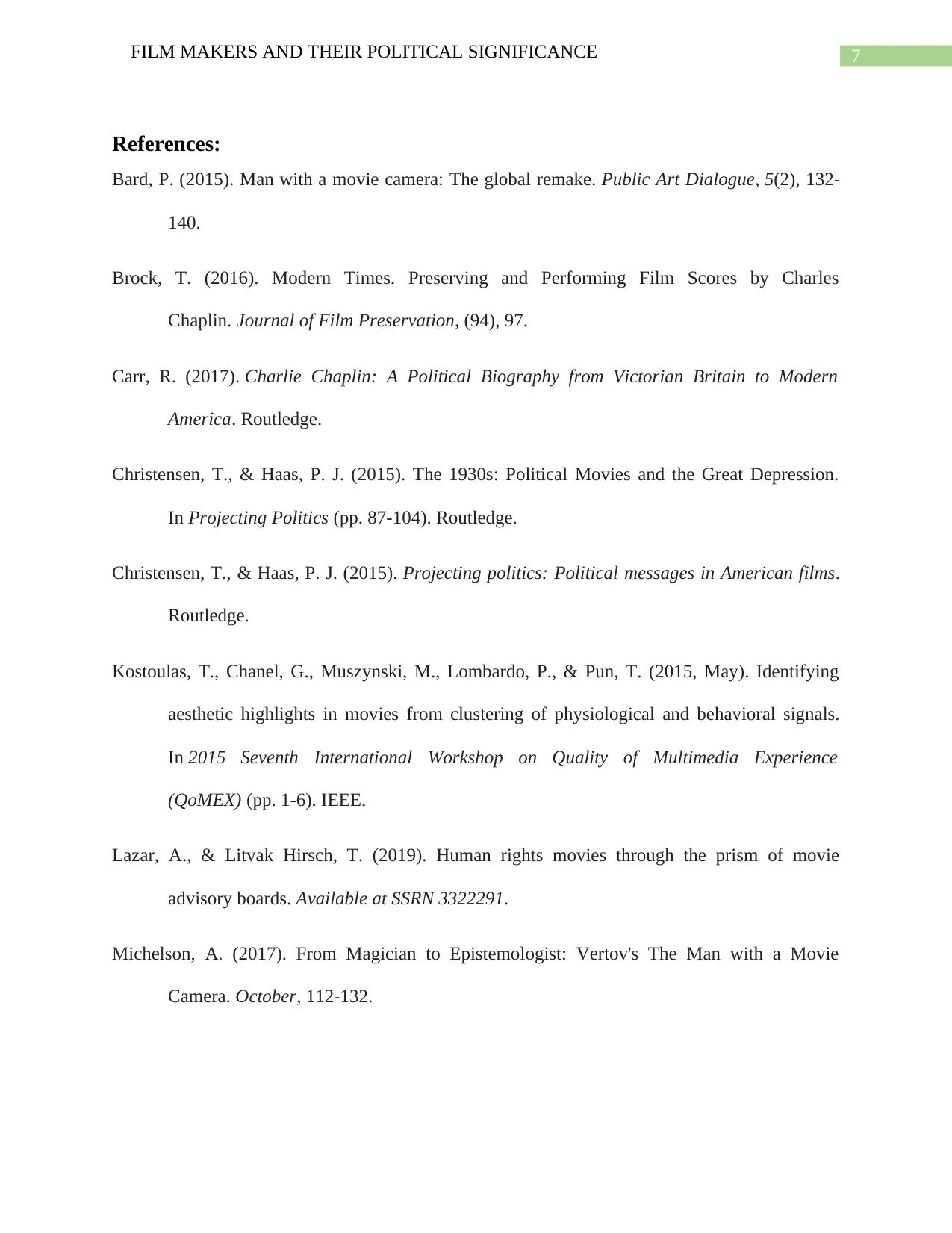
7FILM MAKERS AND THEIR POLITICAL SIGNIFICANCE
References:
Bard, P. (2015). Man with a movie camera: The global remake. Public Art Dialogue, 5(2), 132-
140.
Brock, T. (2016). Modern Times. Preserving and Performing Film Scores by Charles
Chaplin. Journal of Film Preservation, (94), 97.
Carr, R. (2017). Charlie Chaplin: A Political Biography from Victorian Britain to Modern
America. Routledge.
Christensen, T., & Haas, P. J. (2015). The 1930s: Political Movies and the Great Depression.
In Projecting Politics (pp. 87-104). Routledge.
Christensen, T., & Haas, P. J. (2015). Projecting politics: Political messages in American films.
Routledge.
Kostoulas, T., Chanel, G., Muszynski, M., Lombardo, P., & Pun, T. (2015, May). Identifying
aesthetic highlights in movies from clustering of physiological and behavioral signals.
In 2015 Seventh International Workshop on Quality of Multimedia Experience
(QoMEX) (pp. 1-6). IEEE.
Lazar, A., & Litvak Hirsch, T. (2019). Human rights movies through the prism of movie
advisory boards. Available at SSRN 3322291.
Michelson, A. (2017). From Magician to Epistemologist: Vertov's The Man with a Movie
Camera. October, 112-132.
References:
Bard, P. (2015). Man with a movie camera: The global remake. Public Art Dialogue, 5(2), 132-
140.
Brock, T. (2016). Modern Times. Preserving and Performing Film Scores by Charles
Chaplin. Journal of Film Preservation, (94), 97.
Carr, R. (2017). Charlie Chaplin: A Political Biography from Victorian Britain to Modern
America. Routledge.
Christensen, T., & Haas, P. J. (2015). The 1930s: Political Movies and the Great Depression.
In Projecting Politics (pp. 87-104). Routledge.
Christensen, T., & Haas, P. J. (2015). Projecting politics: Political messages in American films.
Routledge.
Kostoulas, T., Chanel, G., Muszynski, M., Lombardo, P., & Pun, T. (2015, May). Identifying
aesthetic highlights in movies from clustering of physiological and behavioral signals.
In 2015 Seventh International Workshop on Quality of Multimedia Experience
(QoMEX) (pp. 1-6). IEEE.
Lazar, A., & Litvak Hirsch, T. (2019). Human rights movies through the prism of movie
advisory boards. Available at SSRN 3322291.
Michelson, A. (2017). From Magician to Epistemologist: Vertov's The Man with a Movie
Camera. October, 112-132.
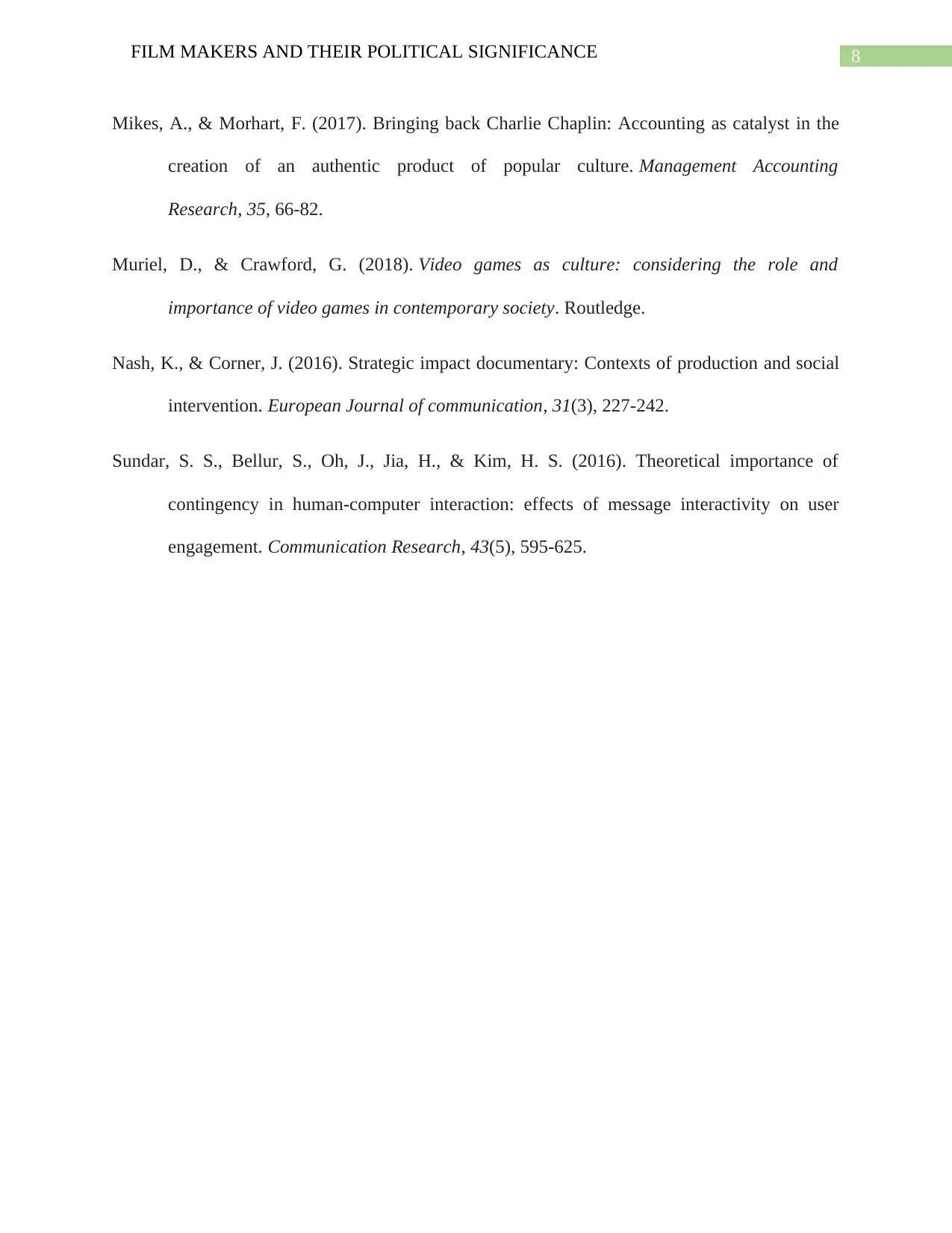
8FILM MAKERS AND THEIR POLITICAL SIGNIFICANCE
Mikes, A., & Morhart, F. (2017). Bringing back Charlie Chaplin: Accounting as catalyst in the
creation of an authentic product of popular culture. Management Accounting
Research, 35, 66-82.
Muriel, D., & Crawford, G. (2018). Video games as culture: considering the role and
importance of video games in contemporary society. Routledge.
Nash, K., & Corner, J. (2016). Strategic impact documentary: Contexts of production and social
intervention. European Journal of communication, 31(3), 227-242.
Sundar, S. S., Bellur, S., Oh, J., Jia, H., & Kim, H. S. (2016). Theoretical importance of
contingency in human-computer interaction: effects of message interactivity on user
engagement. Communication Research, 43(5), 595-625.
Mikes, A., & Morhart, F. (2017). Bringing back Charlie Chaplin: Accounting as catalyst in the
creation of an authentic product of popular culture. Management Accounting
Research, 35, 66-82.
Muriel, D., & Crawford, G. (2018). Video games as culture: considering the role and
importance of video games in contemporary society. Routledge.
Nash, K., & Corner, J. (2016). Strategic impact documentary: Contexts of production and social
intervention. European Journal of communication, 31(3), 227-242.
Sundar, S. S., Bellur, S., Oh, J., Jia, H., & Kim, H. S. (2016). Theoretical importance of
contingency in human-computer interaction: effects of message interactivity on user
engagement. Communication Research, 43(5), 595-625.
⊘ This is a preview!⊘
Do you want full access?
Subscribe today to unlock all pages.

Trusted by 1+ million students worldwide
1 out of 9
Related Documents
Your All-in-One AI-Powered Toolkit for Academic Success.
+13062052269
info@desklib.com
Available 24*7 on WhatsApp / Email
![[object Object]](/_next/static/media/star-bottom.7253800d.svg)
Unlock your academic potential
Copyright © 2020–2025 A2Z Services. All Rights Reserved. Developed and managed by ZUCOL.




